
My Lady Dresses

Introduction
In Elizabethan times, the way that people had to dress was set down by law. Different classes were expected to dress according to their place in society.
Rich women took a great deal of care about the clothes then wore, as the play in Source 1 shows. They also took a great deal of trouble with their make-up (Source 2), although the poisonous lead powder they used to whiten their faces damaged their skin (and sometimes killed them). Many Elizabethan women, however, were slaves to fashion. When their skin was very damaged, they scrubbed it off, and started again on a new layer of skin!
After you have studied this webpage, answer the question sheet by clicking on the 'Time to Work' icon at the top of the page.
Links:
The following websites will help you research further:
Tudor Fashions:
• Tudor fashion
• This BBC Bitesize gallery puts Tudor fashions alongside a sequence of different clothing styles
17th Century Fashions:
• 17th century fashion
• A webpage on common women's clothing
• Simple BBC video
![]()
![]()
![]()
1 Lady and Servant
This playlet comes from Peter Erondell, The French Garden (c.1605), a book of plays written to teach pupils new words.
Lady Ho! Who is in the inner Chamber? Maidens, hear you not? Are you deaf?
Jolye I am heere, Madam.
Lady Will you keepe me heere all the day? Where be all my thinges? Goe fetch my I clothes: bring my damask bodice with whale bones. This lace is too shorte, the tags are broken, I cannot lace myselfe with it, take it away. Give me my peticoate of Crimson velvet with silver fringe. I take colde; where be my stockens? Showe me my Carnation silk stockens; where laid you last night my garters? Take away these slippers, give me my velvet pantoufles.
Jolye, come dresse my head. Set the Table further from the fire, it is too neere. I praye you Jolye, rubbe well my head, for it is very full of dandrufe. Where is my combe? Give me first my combing cloth, otherwise the haires will fall on my cloathes. O God! you combe too hard, you scratch me, you pull out my haires.
Jolye Will it please you to rise up a little, Madame? For your hair is so long, that it trails on the ground.
Lady Take the combe-brushes; take a quill to take away the filth from them. Take the key of my closet, and goe fetch the box where I put my Jewels that I use to wear on my head.
Go too, give me some water to wash, where's my muske ball? Give me rather my paste of Almonds, for it scoureth better: where is my Scarlet cloth to wipe my face? Now set on my necklace of precious stones: call my Taylor to bring my open gowne of white satin layd on with buttons of Pearle. Shall I have no farthingale? You remember nothing, you have a rabbit's memory. Pass me my kirtle of green silk; go to it you head-braine, you doe nothing but playe the foole.
Jolye What doth it please you to have, Madam, a ruff or a Rebato?
Lady Let me see that ruff. Why is the supporter so dirty? I know not for what you are fit, you cannot so much as keep my cloathes cleane; take it away and give me my Rebato.
2 Tudor Make-Up
An Elizabethan lady's beauty regime. This drawing is my a modern artist.
